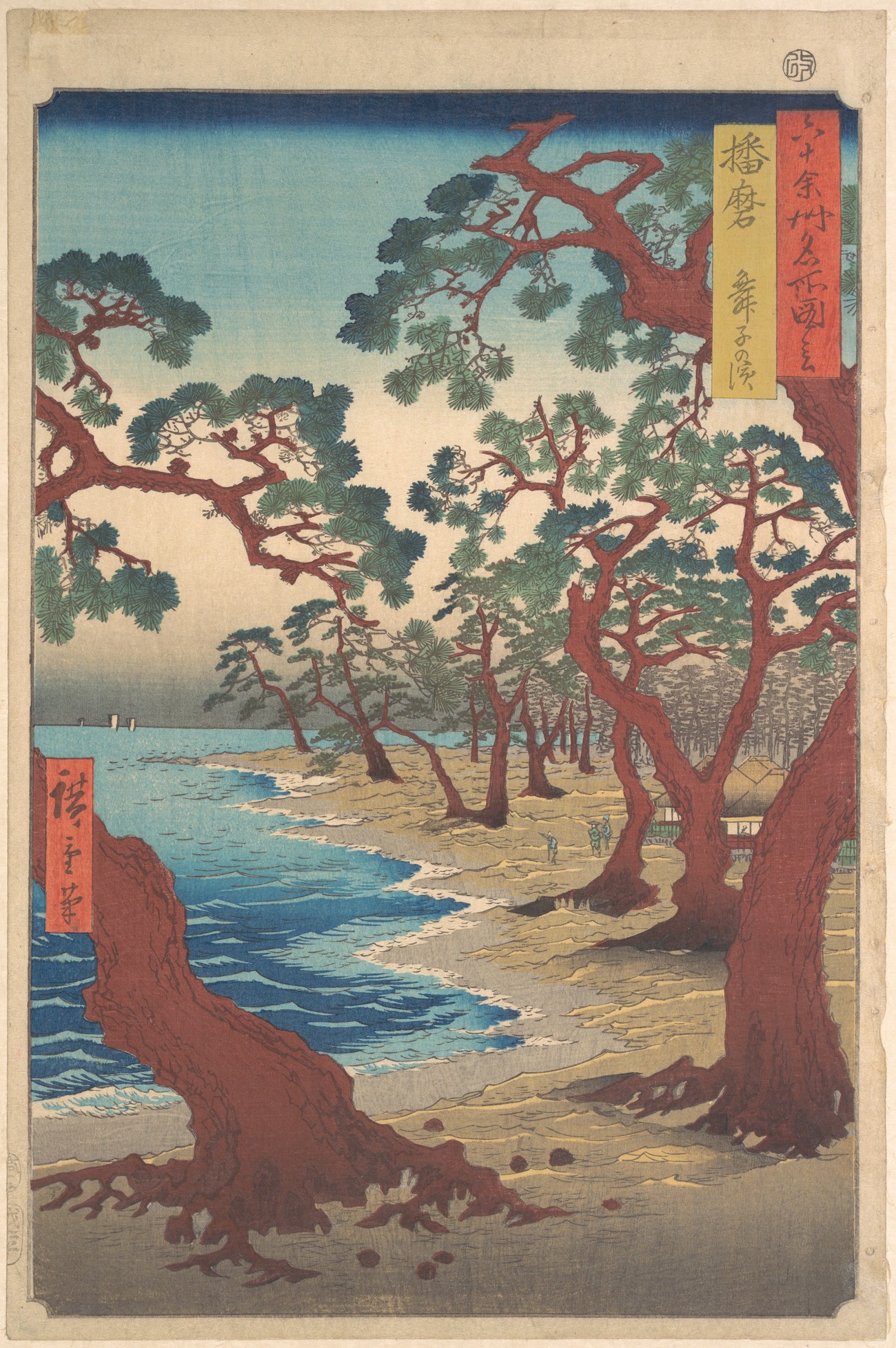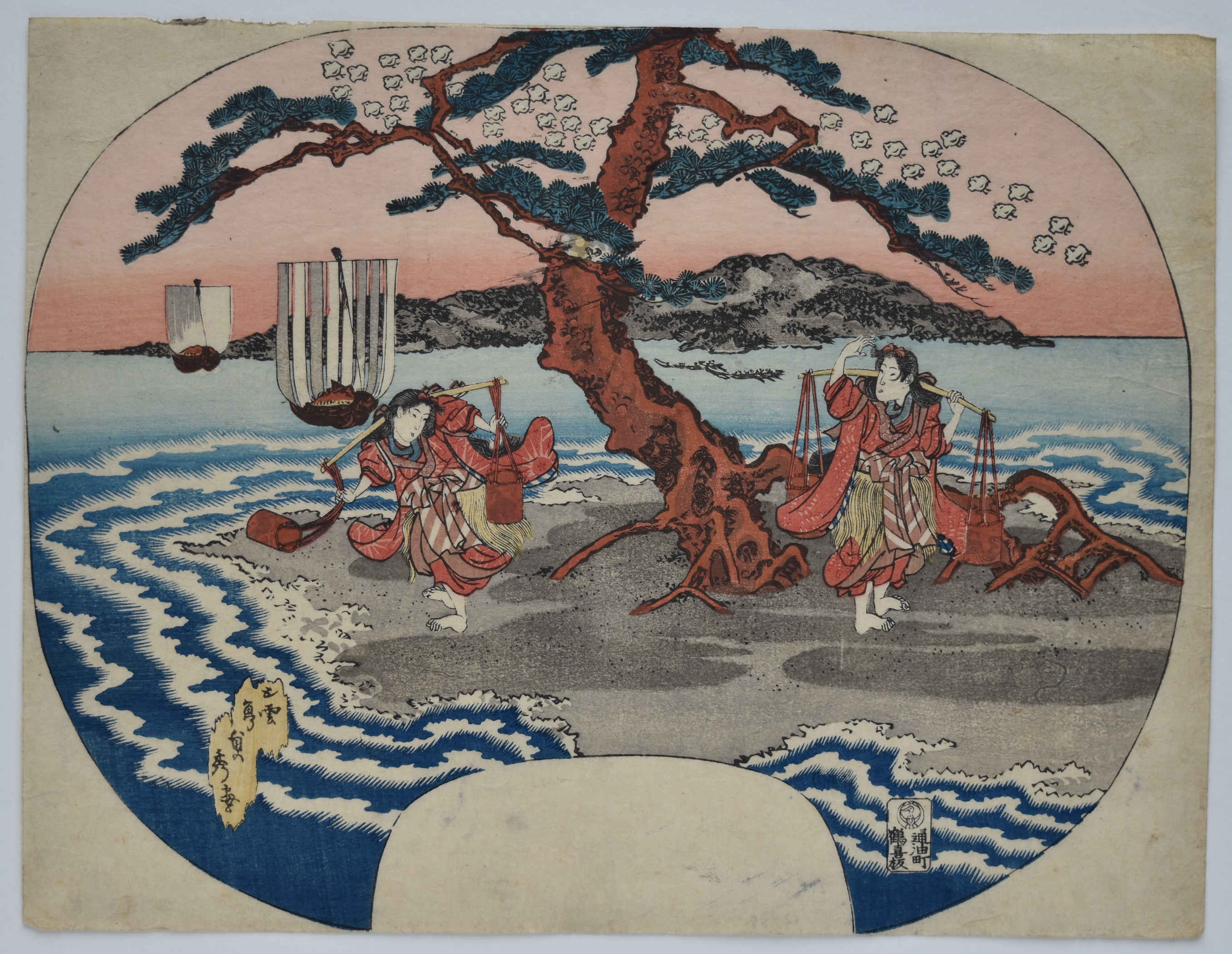 See also Maiko Beach, Harima Province, from the series Views of Famous Places in the Sixty-Odd Provinces,
See also Maiko Beach, Harima Province, from the series Views of Famous Places in the Sixty-Odd Provinces,
-
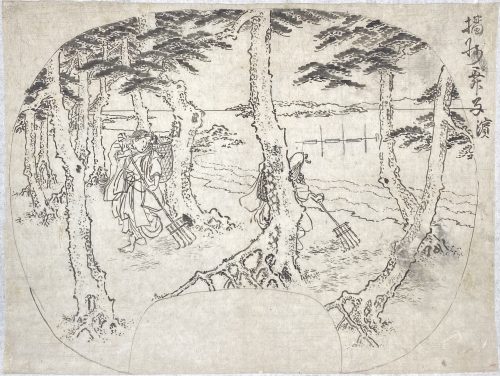 Artist: Veronica Miller attributes the drawing to Utagawa Sadahide [歌川 貞秀] (Japanese, 1807 – 1879), also known as Gountei Sadahide [五雲亭 貞秀]. A preparatory drawing for a fan print depicts two women raking pine needles along the scenic beach at Harima. Inscription at top right "Maiko Beach in Harima" (Harima Maiko no Hama) [播磨 舞子濱], which is now located in Hyōgo Prefecture. The view must be of the Akashi Strait, looking towards Awaji Island. Drawn on thin hanshita paper, mounted lightly at the top to a backing paper, but unbacked. Size: 240 x 319 mm. Attribution to Sadahide based on his design titled "Suma Bay: Matsukaze and Murasame" (see below):
Artist: Veronica Miller attributes the drawing to Utagawa Sadahide [歌川 貞秀] (Japanese, 1807 – 1879), also known as Gountei Sadahide [五雲亭 貞秀]. A preparatory drawing for a fan print depicts two women raking pine needles along the scenic beach at Harima. Inscription at top right "Maiko Beach in Harima" (Harima Maiko no Hama) [播磨 舞子濱], which is now located in Hyōgo Prefecture. The view must be of the Akashi Strait, looking towards Awaji Island. Drawn on thin hanshita paper, mounted lightly at the top to a backing paper, but unbacked. Size: 240 x 319 mm. Attribution to Sadahide based on his design titled "Suma Bay: Matsukaze and Murasame" (see below): See also Maiko Beach, Harima Province, from the series Views of Famous Places in the Sixty-Odd Provinces,
See also Maiko Beach, Harima Province, from the series Views of Famous Places in the Sixty-Odd Provinces,
-
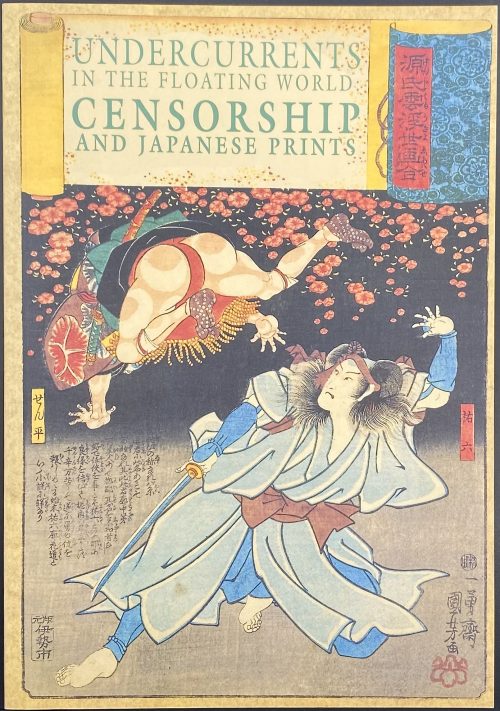 Paperback, 27.5 x 19 cm, pictorial wrappers, lettering to front wrapper and spine, pp.: [i-iv] v-viii, 1-104, ils.: 50 figures; catalogue, notes, and bibliography. Title-page: UNDERCURRENTS | IN THE FLOATING WORLD: | CENSORSHIP | AND JAPANESE PRINTS | Sarah E. Thompson | H. D. Harootunian | {kiwame seal} | THE ASIA SOCIETY GALLERIES | NEW YORK || Exhibition in NY: October 9, 1991 – January 5, 1992. Authors: Sarah E. Thompson (American, b. 1951) Harry D. Harootunian (Armenian-American, b. 1929)
Paperback, 27.5 x 19 cm, pictorial wrappers, lettering to front wrapper and spine, pp.: [i-iv] v-viii, 1-104, ils.: 50 figures; catalogue, notes, and bibliography. Title-page: UNDERCURRENTS | IN THE FLOATING WORLD: | CENSORSHIP | AND JAPANESE PRINTS | Sarah E. Thompson | H. D. Harootunian | {kiwame seal} | THE ASIA SOCIETY GALLERIES | NEW YORK || Exhibition in NY: October 9, 1991 – January 5, 1992. Authors: Sarah E. Thompson (American, b. 1951) Harry D. Harootunian (Armenian-American, b. 1929) -
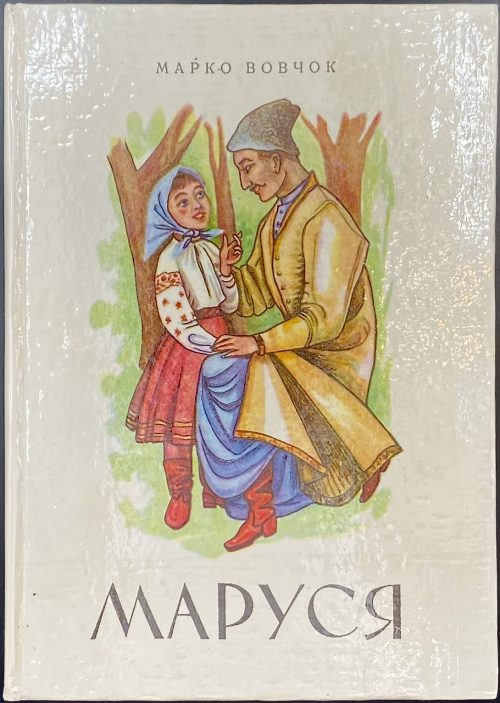 Hardcover, 20.7 x 14.7 cm, pictorial glossy paper over cardboard, vignettes and lettering to front and back covers, pp. [1-2] 3-140 [4]; collated 8vo: 1-98, total 72 leaves. Five full-page plates and numerous tailpieces after woodcuts by Myron Levytsky. This is a translation from the French version of Pierre-Jules Hetzel into Ukrainian, published in Toronto and New York in 1971: Марко Вовчок. Маруся. Повiсть. З французского видання П.-Ж. Сталя. — Торонто, Нью-Йорк: Бiблiотека молодi, 1971. Vignettes to the covers and other design elements are by Л. Гринiв. Title-page: МАРКО ВОВЧОК | МАРУСЯ | ПОВIСТЬ | Львів | “Поклик сумління” | 1993 || Contributors: Марко Вовчок [Marko Vovchok; Марія Олександрівна Вілінська] (Ukrainian, 1833 – 1907) – author. Іван Овксентійович Денисюк (Ukrainin, 1924 – 2009) – author/foreword. Мирон Миколайович Левицький [Myron Levytsky] (Ukrainin-Canadian, 1913 – 1993) – artist. Pierre-Jules Hetzel [P.-J. Stahl] (French, 1814 – 1886) – author. The French version of the Ukrainian name Маруся —> MAROUSSIA. The French version of the book: LIB-2674.2021; other copies of the Ukrainian edition (1943): LIB-3136.2023, LIB-3137.2023 (1959) and LIB-3170.2023 – all translated from the Russian by Vasyl Domanytskyi [Василь Миколайович Доманицький, Василий Николаевич Доманицкий] (Ukrainian, 1877 – 1910). Other variants of the name Марко Вовчок: Markowovzok and Marko Vovtchok.
Hardcover, 20.7 x 14.7 cm, pictorial glossy paper over cardboard, vignettes and lettering to front and back covers, pp. [1-2] 3-140 [4]; collated 8vo: 1-98, total 72 leaves. Five full-page plates and numerous tailpieces after woodcuts by Myron Levytsky. This is a translation from the French version of Pierre-Jules Hetzel into Ukrainian, published in Toronto and New York in 1971: Марко Вовчок. Маруся. Повiсть. З французского видання П.-Ж. Сталя. — Торонто, Нью-Йорк: Бiблiотека молодi, 1971. Vignettes to the covers and other design elements are by Л. Гринiв. Title-page: МАРКО ВОВЧОК | МАРУСЯ | ПОВIСТЬ | Львів | “Поклик сумління” | 1993 || Contributors: Марко Вовчок [Marko Vovchok; Марія Олександрівна Вілінська] (Ukrainian, 1833 – 1907) – author. Іван Овксентійович Денисюк (Ukrainin, 1924 – 2009) – author/foreword. Мирон Миколайович Левицький [Myron Levytsky] (Ukrainin-Canadian, 1913 – 1993) – artist. Pierre-Jules Hetzel [P.-J. Stahl] (French, 1814 – 1886) – author. The French version of the Ukrainian name Маруся —> MAROUSSIA. The French version of the book: LIB-2674.2021; other copies of the Ukrainian edition (1943): LIB-3136.2023, LIB-3137.2023 (1959) and LIB-3170.2023 – all translated from the Russian by Vasyl Domanytskyi [Василь Миколайович Доманицький, Василий Николаевич Доманицкий] (Ukrainian, 1877 – 1910). Other variants of the name Марко Вовчок: Markowovzok and Marko Vovtchok. -
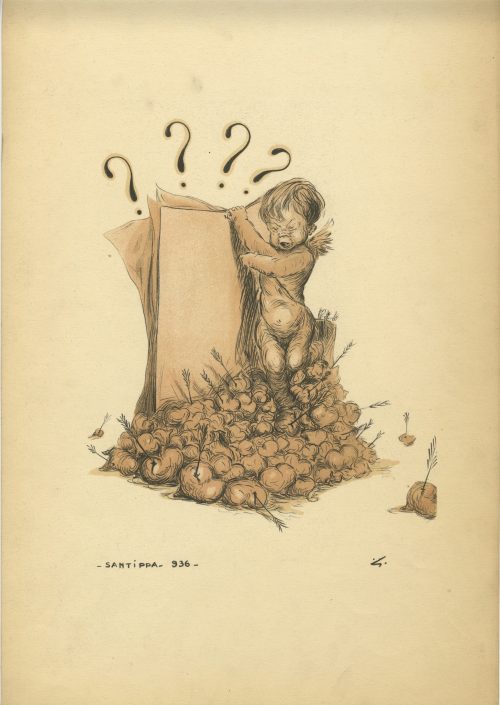 Publisher's flapped folder of black velvet paper with dark green embossed vignette, 494 x 325 mm, with a pink limitation label inside the front cover and a printed spade with 'FIN" inside the back cover; a set of 13 lithographs signed Santippa, 936; 480 x 310 mm each, twelve in black and one (title) coloured with sanguine. Limited edition of 250 copies, 1-100 printed on Hollande and 150 on Japon; this is copy № 127.
Publisher's flapped folder of black velvet paper with dark green embossed vignette, 494 x 325 mm, with a pink limitation label inside the front cover and a printed spade with 'FIN" inside the back cover; a set of 13 lithographs signed Santippa, 936; 480 x 310 mm each, twelve in black and one (title) coloured with sanguine. Limited edition of 250 copies, 1-100 printed on Hollande and 150 on Japon; this is copy № 127.Titles: Rêverie, Gaspillage, Exagération, Simplicité, Gourmandise, Abondance, Violence, Fantaisie, Faiblesse, Curiosité, Obligeance, Surprise.
Contributors:Gaston Hoffmann [Santippa] (French, 1883 – 1977)
-
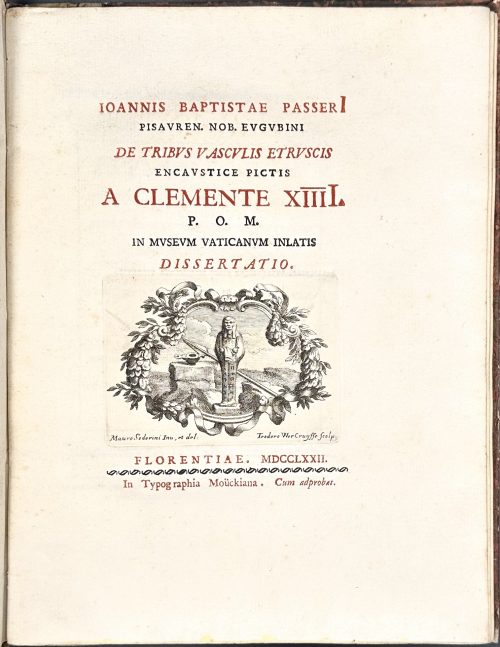 Owner’s wrappers, 28 x 21 cm, printed on laid paper, unpaginated, collated ffl, [A, B]4 C-G4, 2 ffl; total 28 leaves plus 5 engraved plates by Allegrini after Mariotti; engraved title-page (Vercruys after Soderini), head- and tailpieces (Gregori after del Moro) and initials. Owner's label to front pastedown: Marc Burdin, prêtre. Title-page (engraved, red and black): IOANNIS BAPTISTAE PASSERI | PISAUREN. NOB. EUGUBINI | DE TRIBUS VASCULIS ETRUSCIS | ENCAUSTICE PICTIS | A CLEMENTE XIIII. | P.O.M. | IN MUSEUM VATICANUM INLATIS | DISSERTATIO. | {VIGNETTE} | FLORENTIAE. MDCCLXXII. | ~ | in Typographia Moückiana. Cum adprobat. || Dedication: ANTIQVARIAE. ERVDITIONIS. PROPAGATORI EXIMIO ABSOLVTISSIMAM . HANC. DISSERTATIONEM CLARISS. PASSERII DE . IMAGINIBVS . ET . SYMBOLIS TRIVM . VASORVM . ETRVSCI . OPERIS QVAE PRINCIPIS. NOSTRI.SANCTISS. ET. SAPIENTISS. LARGITATE IN . VATICANVM . MVSEVM A. SE. CVMVLATISSIME . DITATVM INVE CTA . FVERVNT REGINALDVS.COMES.ANSIDAEVS.PATR.PERVS. M. A. CARD. PRONEPOS DEVOTVS. NOMINI . MAIESTATIQVE . EIVS DEMISSISSIME. Translation: "To the most excellent promoter of antiquities, the most accomplished: This most complete dissertation concerning the images and symbols of three Etruscan vases, which were most abundantly bestowed by our most holy and wise Prince onto the Vatican museum, was composed by the illustrious Passerius. Reginald, Count of Ansidius, true ancestral father, grandson by blood of the Cardinal, devoted most humbly and devoutly to his name and majesty." Note: P.O.M. stands for "Papa Optimo Maximo", which translates to "Father Most Excellent." For a similar vase in this collection, see VO-0098.
Owner’s wrappers, 28 x 21 cm, printed on laid paper, unpaginated, collated ffl, [A, B]4 C-G4, 2 ffl; total 28 leaves plus 5 engraved plates by Allegrini after Mariotti; engraved title-page (Vercruys after Soderini), head- and tailpieces (Gregori after del Moro) and initials. Owner's label to front pastedown: Marc Burdin, prêtre. Title-page (engraved, red and black): IOANNIS BAPTISTAE PASSERI | PISAUREN. NOB. EUGUBINI | DE TRIBUS VASCULIS ETRUSCIS | ENCAUSTICE PICTIS | A CLEMENTE XIIII. | P.O.M. | IN MUSEUM VATICANUM INLATIS | DISSERTATIO. | {VIGNETTE} | FLORENTIAE. MDCCLXXII. | ~ | in Typographia Moückiana. Cum adprobat. || Dedication: ANTIQVARIAE. ERVDITIONIS. PROPAGATORI EXIMIO ABSOLVTISSIMAM . HANC. DISSERTATIONEM CLARISS. PASSERII DE . IMAGINIBVS . ET . SYMBOLIS TRIVM . VASORVM . ETRVSCI . OPERIS QVAE PRINCIPIS. NOSTRI.SANCTISS. ET. SAPIENTISS. LARGITATE IN . VATICANVM . MVSEVM A. SE. CVMVLATISSIME . DITATVM INVE CTA . FVERVNT REGINALDVS.COMES.ANSIDAEVS.PATR.PERVS. M. A. CARD. PRONEPOS DEVOTVS. NOMINI . MAIESTATIQVE . EIVS DEMISSISSIME. Translation: "To the most excellent promoter of antiquities, the most accomplished: This most complete dissertation concerning the images and symbols of three Etruscan vases, which were most abundantly bestowed by our most holy and wise Prince onto the Vatican museum, was composed by the illustrious Passerius. Reginald, Count of Ansidius, true ancestral father, grandson by blood of the Cardinal, devoted most humbly and devoutly to his name and majesty." Note: P.O.M. stands for "Papa Optimo Maximo", which translates to "Father Most Excellent." For a similar vase in this collection, see VO-0098.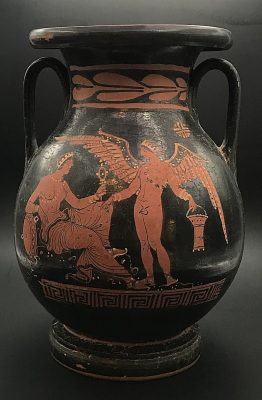
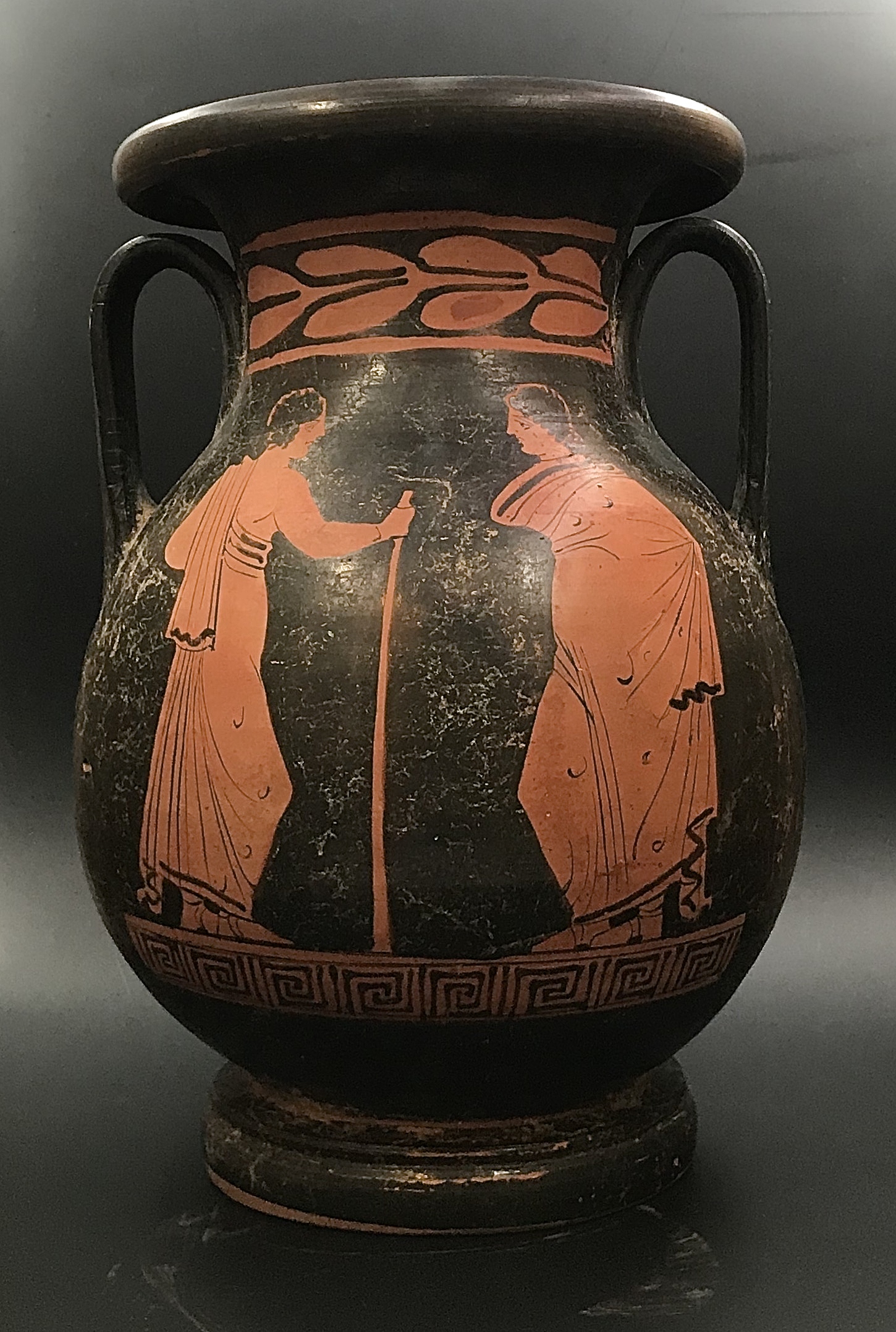 This vase is attributed to Apulia, ca. 330 BCE. Probably, Passeri was wrong in attributing this type of vessel to Etruscan vase painting, produced from the 7th through the 4th centuries BC.
Contributors:
Giovanni Battista Passeri (Italian, 1694 – 1780) – author.
Francesco Moücke (Italian, fl. 1729 – 1787) – publisher.
Pope Clement XIV [Ganganelli, Giovanni Vincenzo Antonio] (Italian, 1705 – 1774) – dedicatee.
Artists:
Mauro Soderini (Italian, 1704 – after 1751)
Carlo Spiridione Mariotti (Italian, 1726 – 1790)
Lorenzo del Moro (Italian, 1677 – 1735)
Engravers:
Theodor Vercruys [Teodoro Vercruysse] (Dutch, 1678 – 1739)
Francesco Allegrini da Gubbio (Italian, 1587 – 1663)
Carlo Bartolomeo Gregori (Italian, 1702 – 1759)
This vase is attributed to Apulia, ca. 330 BCE. Probably, Passeri was wrong in attributing this type of vessel to Etruscan vase painting, produced from the 7th through the 4th centuries BC.
Contributors:
Giovanni Battista Passeri (Italian, 1694 – 1780) – author.
Francesco Moücke (Italian, fl. 1729 – 1787) – publisher.
Pope Clement XIV [Ganganelli, Giovanni Vincenzo Antonio] (Italian, 1705 – 1774) – dedicatee.
Artists:
Mauro Soderini (Italian, 1704 – after 1751)
Carlo Spiridione Mariotti (Italian, 1726 – 1790)
Lorenzo del Moro (Italian, 1677 – 1735)
Engravers:
Theodor Vercruys [Teodoro Vercruysse] (Dutch, 1678 – 1739)
Francesco Allegrini da Gubbio (Italian, 1587 – 1663)
Carlo Bartolomeo Gregori (Italian, 1702 – 1759) -
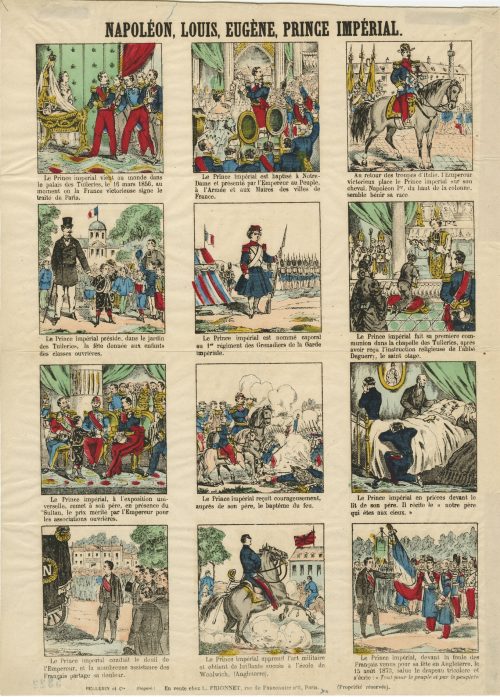 Another copy of SVFC-0745-3.2023, 395 x 290 mm; black ink stamp “5322” to reverse. Jean Charles Pellerin (French, 1756 – 1836)
Another copy of SVFC-0745-3.2023, 395 x 290 mm; black ink stamp “5322” to reverse. Jean Charles Pellerin (French, 1756 – 1836) -
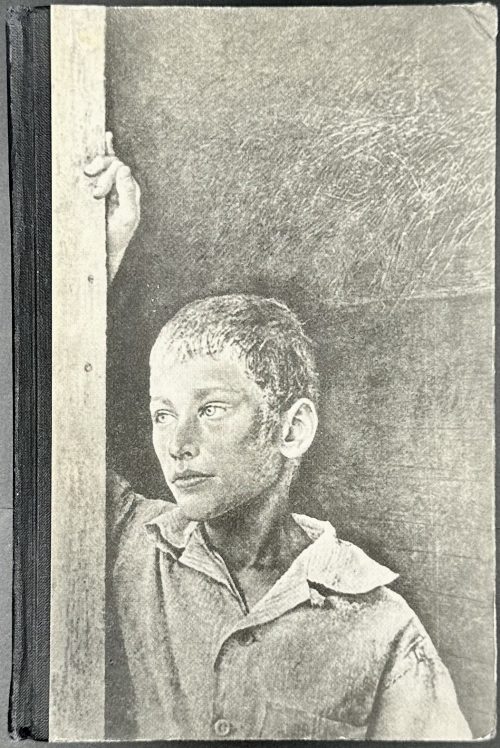 Hardcover, 22.2 x 14.6 cm, quarter black cloth, pictorial boards, lettering to spine; pp.: [2] 3-253 [3], collated 8vo: 1-168, total 128 leaves plus portrait frontispiece. Title-page: Дж. Д. СЭЛИНДЖЕР | ПОВЕСТИ | НАД ПРОПАСТЬЮ | ВО РЖИ | ВЫШЕ СТРОПИЛА, | ПЛОТНИКИ | РАССКАЗЫ | ХОРОШО ЛОВИТСЯ | РЫБКА-БАНАНКА | ЧЕЛОВЕК, КОТОРЫЙ | СМЕЯЛСЯ | ГОЛУБОЙ ПЕРИОД | ДЕ ДОМЬЕ-СМИТА | ЛАПА-РАСТЯПА | ПЕРЕВОД С АНГЛИЙСКОГО | И ПРЕДИСЛОВИЕ | Р. РАЙТ-КОВАЛЕВОЙ | ИЗДАТЕЛЬСТВО ЦК ВЛКСМ | «МОЛОДАЯ ГВАРДИЯ», 1965 || T.p. verso: […] J. D. Salinger | The Catcher in the Rye | Raise high the Roof Beam, Carpenters | A Perfect Day for Bananafish | The Laughing Man | De Daumier — Smith’s Blue Period | Uncle Wiggly in Connecticut | Художник Б. Жутовский | (В оформлении использован фрагмент картины | американского художника Э. Уайеса) || Print run: 115,000 copies. Contributors: [Джером Дэвид Сэлинджер] Jerome David Salinger (American, 1919 – 2010) Райт-Ковалёва, Рита [Черномордик, Раиса Яковлевна] (Russian, 1898 – 1988) Жутовский, Борис Иосифович (Russian, 1932 – 2023) «Э. Уайес» – [Эндрю Уайет] Andrew Wyeth (American, 1917 – 2009)
Hardcover, 22.2 x 14.6 cm, quarter black cloth, pictorial boards, lettering to spine; pp.: [2] 3-253 [3], collated 8vo: 1-168, total 128 leaves plus portrait frontispiece. Title-page: Дж. Д. СЭЛИНДЖЕР | ПОВЕСТИ | НАД ПРОПАСТЬЮ | ВО РЖИ | ВЫШЕ СТРОПИЛА, | ПЛОТНИКИ | РАССКАЗЫ | ХОРОШО ЛОВИТСЯ | РЫБКА-БАНАНКА | ЧЕЛОВЕК, КОТОРЫЙ | СМЕЯЛСЯ | ГОЛУБОЙ ПЕРИОД | ДЕ ДОМЬЕ-СМИТА | ЛАПА-РАСТЯПА | ПЕРЕВОД С АНГЛИЙСКОГО | И ПРЕДИСЛОВИЕ | Р. РАЙТ-КОВАЛЕВОЙ | ИЗДАТЕЛЬСТВО ЦК ВЛКСМ | «МОЛОДАЯ ГВАРДИЯ», 1965 || T.p. verso: […] J. D. Salinger | The Catcher in the Rye | Raise high the Roof Beam, Carpenters | A Perfect Day for Bananafish | The Laughing Man | De Daumier — Smith’s Blue Period | Uncle Wiggly in Connecticut | Художник Б. Жутовский | (В оформлении использован фрагмент картины | американского художника Э. Уайеса) || Print run: 115,000 copies. Contributors: [Джером Дэвид Сэлинджер] Jerome David Salinger (American, 1919 – 2010) Райт-Ковалёва, Рита [Черномордик, Раиса Яковлевна] (Russian, 1898 – 1988) Жутовский, Борис Иосифович (Russian, 1932 – 2023) «Э. Уайес» – [Эндрю Уайет] Andrew Wyeth (American, 1917 – 2009) -
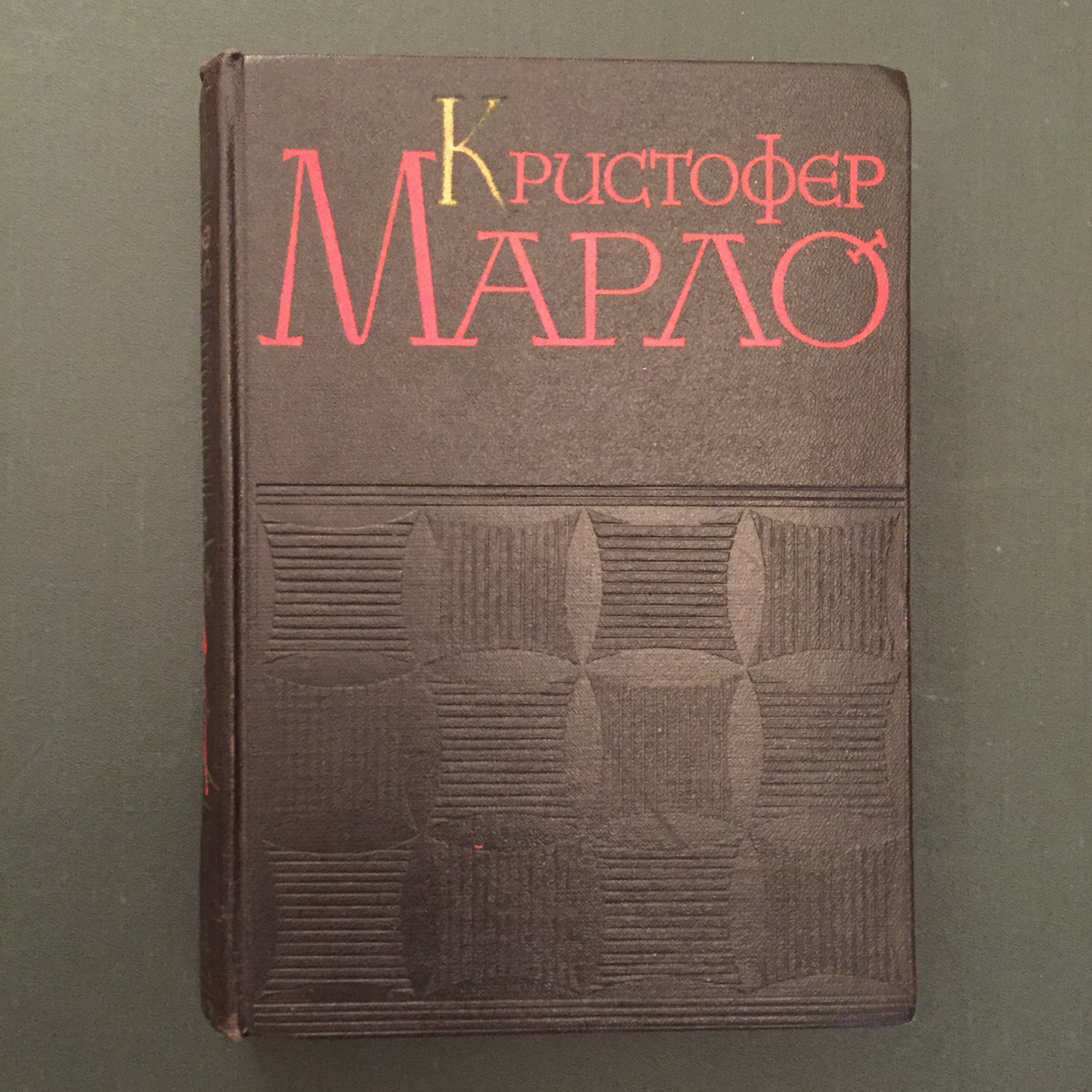
Кристофер Марло. Сочинения. Вступительная статья и комментарии А. Парфенова. Редакция переводов А. Смирнова. Оформление художника В. Носкова. - М.: Государственное издательство художественной литературы, 1961. 664 с.
А. Парфенов. Кристофер Марло.
Тамерлан Великий. Часть 1 - перевод Э. Линецкой; Часть 2 - перевод Е. Полонской.
Трагическая история доктора Фауста. Перевод Е. Бируковой.
Мальтийский еврей. Перевод В. Рождественского.
Эдуард II. Перевод А. Радловой.
Парижская резня. Перевод Ю. Корнева.
Геро и Леандр. Перевод Ю. Корнева.
Страстный пастух - своей возлюбленной. Перевод И. Жданова.
-
 Artist: Utagawa Kunisada [歌川 国貞] a.k.a. Utagawa Toyokuni III [三代歌川豊国] (Japanese, 1786 – 1865). Publisher: Iseya Sōemon [伊勢屋惣右衛門] (Japanese, c. 1776 – 1862). Signed: Kunisada ga within a double toshidama. Date-kiwame seals: Bunsei 11 (1828).
Artist: Utagawa Kunisada [歌川 国貞] a.k.a. Utagawa Toyokuni III [三代歌川豊国] (Japanese, 1786 – 1865). Publisher: Iseya Sōemon [伊勢屋惣右衛門] (Japanese, c. 1776 – 1862). Signed: Kunisada ga within a double toshidama. Date-kiwame seals: Bunsei 11 (1828). -
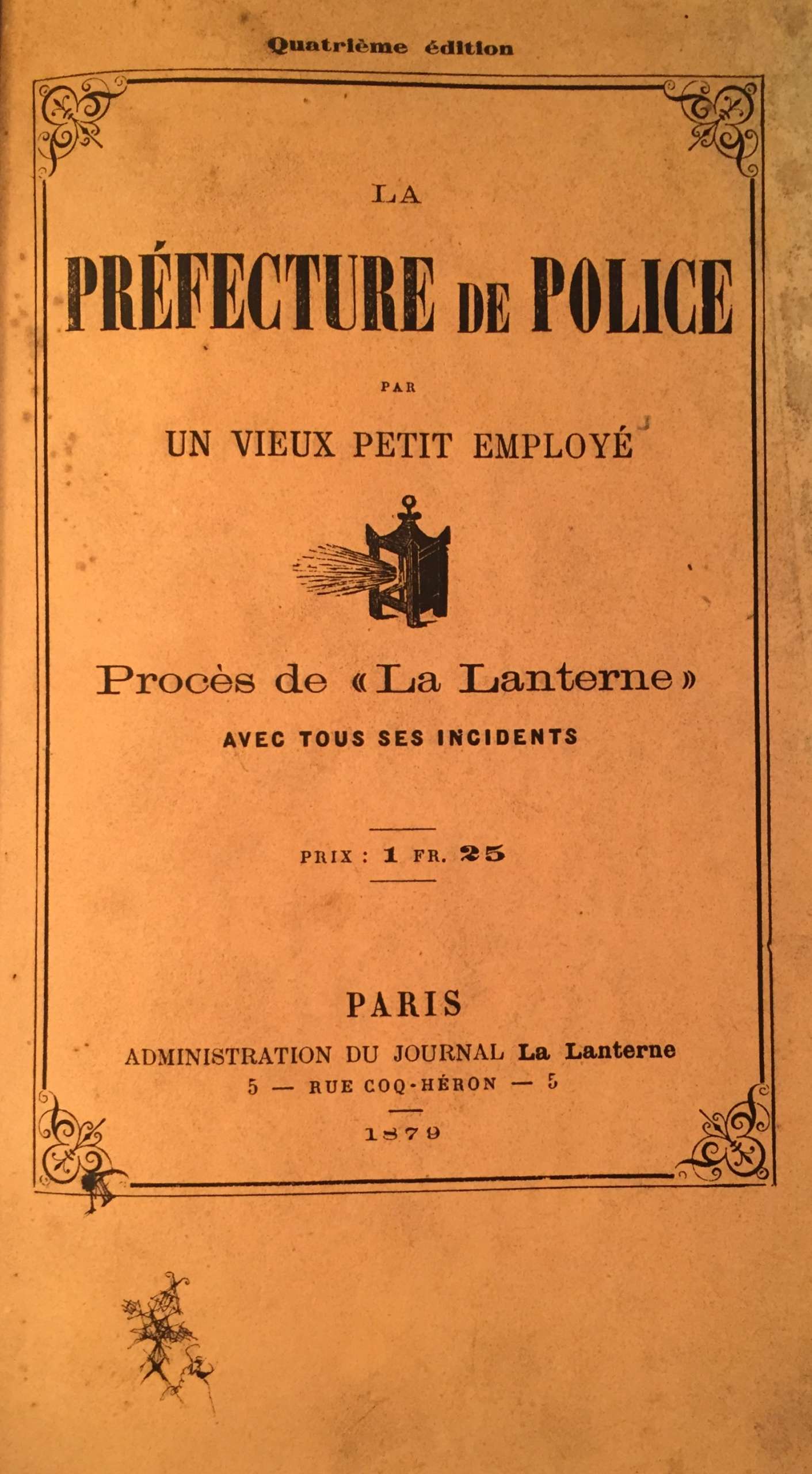
La Préfecture de Police, par un vieux petit employé - Procès de La Lanterne avec tous ses incidents. Administration du journal La Lanterne, Paris, 1879.
Quatrième édition.
Anonymous publication. Authorship attributed to: Yves Guyot, Francisque Sarcey. Source: Harvard College Library, Soc. 3375.6, 14-OCT-1914, Wolcott Fund.
-

Iron tsuba of round form with design of hatchet, snowflake, and triple diamond in openwork (ko-sukashi), and inlaid with five concentric circles of brass dots (ten-zōgan) and brass inner circular line. Sukashi elements outlined in brass.
Late Muromachi period. Diameter: 82.4 mm; Thickness: 3.0 mm The triple lozenge (or diamond) is similar to the one on TSU-305 from Sasano Collection # 15. Very old motif; as Sasano remarks in his book "...represents the unstable political situation at the time".Kokusai Tosogu Kai 5th International Convention & Exhibition, October 28-30, 2009 at NEZU Museum, Tokyo, Japan, on page 83 provides the following explanation of the triple diamond symbol: "The pine bark is the form of the Diamonds, "Bishi", mon, seen from Nara period, found on cloth stored in the Shoso In, and used primarily by the Takeda family. The form of Bishi mon [similar to ours] is called "Chu Kage Matsukawa Bishi", (Middle Shaded Pine Bark Diamond)."
A combination of hatchet (usually an axe) and a triple diamond (Matsukawabishi) alludes to the Nō play Hachi-no-ki (ref: Iron tsuba. The works of the exhibition "Kurogane no hana", The Japanese Sword Museum, 2014; AND Sasano: Japanese Sword Guard Masterpieces from the Sasano Collection. By Sasano Masayuki. Part One. Published in Japan in 1994. -
 Iron tsuba of round form with design of lattice (kōshi-mon, 格子文) cut in openwork (sukashi), with low relief shallow linear carving along the bars. Well forged plate with brown-ish hue. To the right of nakago-ana there is a clear inscription of the character Shō (正), which is explained by Markus Sesko is follows: "The Shinsa obviously recognized more from the signature when having the tsuba in hand, i.e. they were confident to say it is signed "Shōami" but the rest is illegible (ika-fumei, 以下不明). That is, if they were just able to read the first character SHŌ (正) and saw that there were two more, most likely A (阿) and MI (弥), they would have put those character in boxes on the paper. Boxes around characters namely means that the character is not 100% legible but it can be assumed what it is." Momoyama or early Edo period. Dimensions: 85.9 mm diameter, 3.6 mm thickness at seppa-dai. Weight: 79 g. NBTHK certificate № 425069 with attestation: Hozon - "Worthy of preservation". A similar tsuba is presented at Japanese Sword Fittings from the R. B. Caldwell Collection. Sale LN4188 "HIGO". Sotheby's, 30th March 1994, №15. The description says: "A rare early Kamakura-bori tsuba. Nambokucho period (late 14th century). Of circular form, the dark plate carved and pierced with a gate design, the struts with double engraved lines. Unsigned. 8.5 cm." The lot was sold for 1,840 GBP.We have two possible explanations of the discrepancy between Sotheby's and Shinsa/Sesko attribution: 1) either Sotheby's or Shinsa/Sesko were wrong in their attribution or 2) these are two different pieces, one - Kamakura-bori from the 14th century and another - Shōami from 16th/17th century. Anyway, I would consider my piece as a Shōami tsuba of Momoyama - early Edo period, just for the sake of modesty.
Iron tsuba of round form with design of lattice (kōshi-mon, 格子文) cut in openwork (sukashi), with low relief shallow linear carving along the bars. Well forged plate with brown-ish hue. To the right of nakago-ana there is a clear inscription of the character Shō (正), which is explained by Markus Sesko is follows: "The Shinsa obviously recognized more from the signature when having the tsuba in hand, i.e. they were confident to say it is signed "Shōami" but the rest is illegible (ika-fumei, 以下不明). That is, if they were just able to read the first character SHŌ (正) and saw that there were two more, most likely A (阿) and MI (弥), they would have put those character in boxes on the paper. Boxes around characters namely means that the character is not 100% legible but it can be assumed what it is." Momoyama or early Edo period. Dimensions: 85.9 mm diameter, 3.6 mm thickness at seppa-dai. Weight: 79 g. NBTHK certificate № 425069 with attestation: Hozon - "Worthy of preservation". A similar tsuba is presented at Japanese Sword Fittings from the R. B. Caldwell Collection. Sale LN4188 "HIGO". Sotheby's, 30th March 1994, №15. The description says: "A rare early Kamakura-bori tsuba. Nambokucho period (late 14th century). Of circular form, the dark plate carved and pierced with a gate design, the struts with double engraved lines. Unsigned. 8.5 cm." The lot was sold for 1,840 GBP.We have two possible explanations of the discrepancy between Sotheby's and Shinsa/Sesko attribution: 1) either Sotheby's or Shinsa/Sesko were wrong in their attribution or 2) these are two different pieces, one - Kamakura-bori from the 14th century and another - Shōami from 16th/17th century. Anyway, I would consider my piece as a Shōami tsuba of Momoyama - early Edo period, just for the sake of modesty.
Caldwell Collection. Sotheby's 1994, №15.
-
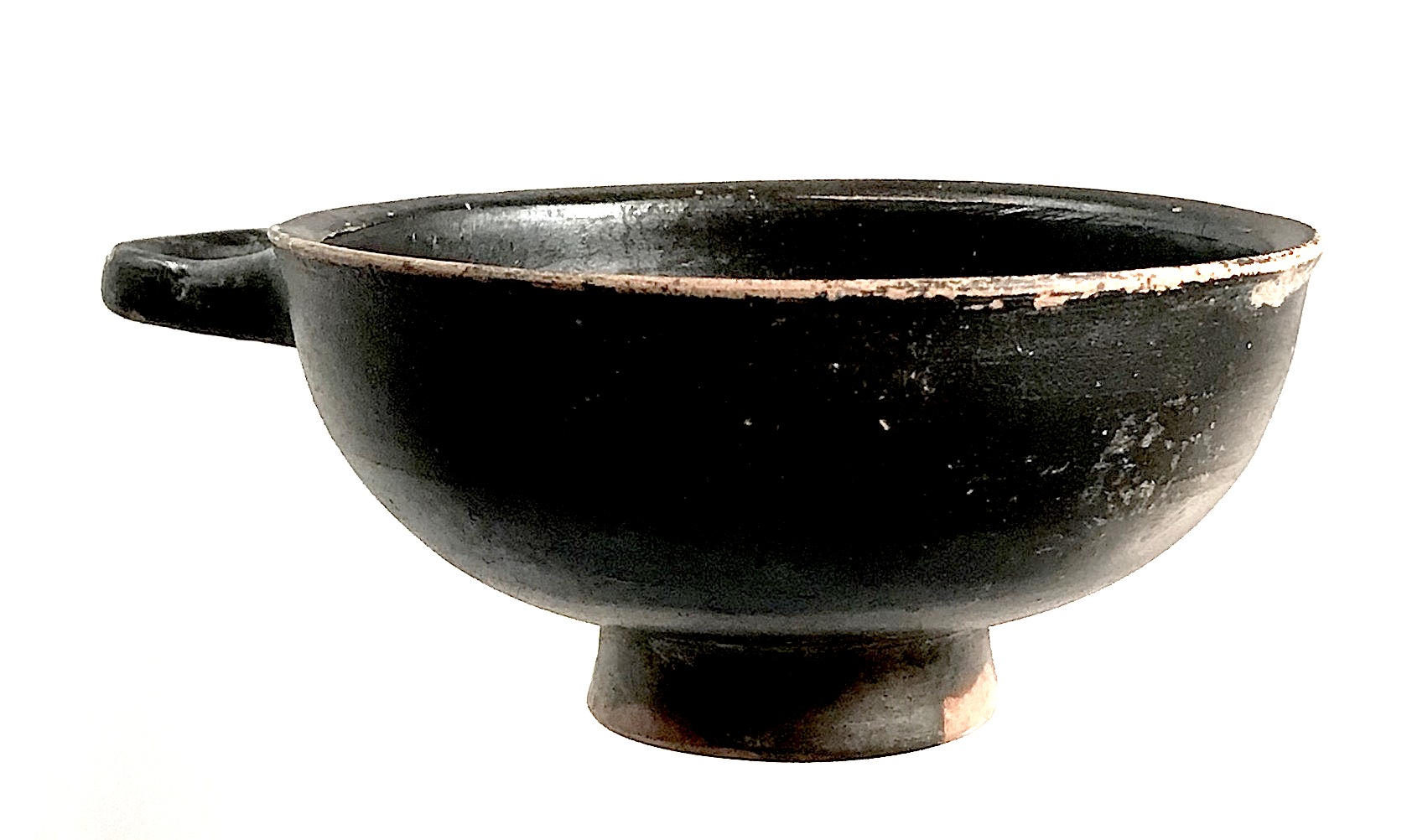 Ancient Greek glazed terracotta kylix (cup with a shallow bowl and a stem), ca. 350 BC. Dimensions: 14.4 x 11 cm The primary use for the kylix was drinking wine (usually mixed with water, and sometimes other flavourings) at a symposium or male "drinking party" in the ancient Greek world, so they are often decorated with scenes of a humorous, light-hearted, or sexual nature that would only become visible when the cup was drained.
Ancient Greek glazed terracotta kylix (cup with a shallow bowl and a stem), ca. 350 BC. Dimensions: 14.4 x 11 cm The primary use for the kylix was drinking wine (usually mixed with water, and sometimes other flavourings) at a symposium or male "drinking party" in the ancient Greek world, so they are often decorated with scenes of a humorous, light-hearted, or sexual nature that would only become visible when the cup was drained. -
 Heianjō tsuba, carved and inlayed in brass with a somewhat primitive design of rocks, plants, and waves, and a man in a boat beside two jakugo stone baskets on the face and a religious structure (stupa, grave stone) on the reverse. Muromachi or Momoyama period.
Heianjō tsuba, carved and inlayed in brass with a somewhat primitive design of rocks, plants, and waves, and a man in a boat beside two jakugo stone baskets on the face and a religious structure (stupa, grave stone) on the reverse. Muromachi or Momoyama period.Size: 83.2 x 82.4 x 3.6 mm; 149.2 g
The Carlo Monzino Collection of Japanese sword fittings and swords (Sotheby's, London, 18 June 1996. p. 12-13) №9 provides an illustration of the similar tsuba with the following description: Heianjo tsuba, carved and inlayed with rocks, plants, and waves, also pierced with a jakago [sic] (stone basket).
Gary D. Murtha in his Japanese sword guards Onin - Heianjo - Yoshiro (GDM Publications, 2016) on page 53 shows a look-a-like tsuba (though, with a kogai-hitsu-ana) with the follwoing description: Iron, 77 mm, tsuba with brass tree, snake, jakugo baskets, and curved brass pieces (representing water flowing over rocks). Buddhist halo to reverse. Although showing Onin traits, a Shoami Heiamjo attribution would fit better. Azuchi-Momoyama period.

-

Iron tsuba of oval form decorated with design of jakago (bamboo lattice work) in openwork (sukashi). Copper sekigane.
Unsigned. Edo period.
Size: 73.7 x 70.3 x 5.6 mm.Note regarding design: though some might think that this piece belonged to a member of the lost tribe of Israel, it did not. Jakago baskets were made of bamboo, filled with rocks and used to catch crabs (besides other uses).

Jeanne Allen. Designer's Guide to Samurai Patterns. Chronicle Books, San Francisco, 1990; p.51, №57.
-
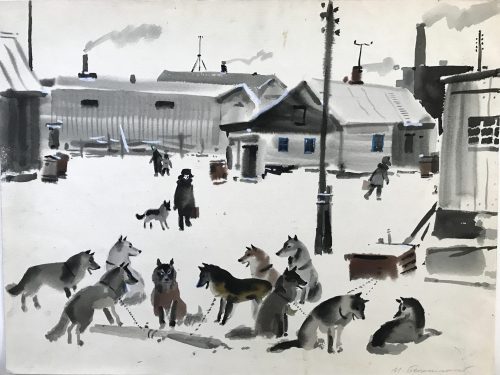 Mikhail Belomlinsky. Born 1934, Russia. Village, dogs. Watercolor painting on paper from Chukotka expedition, 1975. Size: 36 x 48 cm.
Mikhail Belomlinsky. Born 1934, Russia. Village, dogs. Watercolor painting on paper from Chukotka expedition, 1975. Size: 36 x 48 cm. -
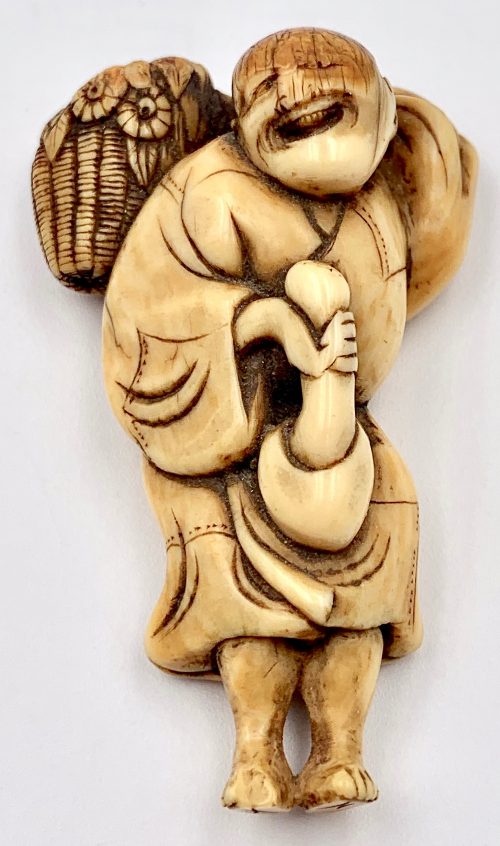
Netsuke with a design of a laughing peasant carrying a basket and holding a giant mushroom in his right hand.
18th century Dimensions: 55.7 mm tallUnsigned. According to Merrily Baird (Symbols of Japan, page. 93): ...Theis prominent use in the symbol-rich netsuke art form, however, reflects more their sexual symbolism than either their dietary appeal or interesting shapes. Mushrooms in Japan are generally a symbol of fertility, with some flat varieties, like shiitake, being associated with females. In contrast, the matsutake mushroom (Armillaria edodes) is a phallic symbol, as befits its thick, spearlike stem and the fact that it is consumed before cap opens.

Female Daruma Riding a Mushroom. Ippitsusai Bunchô. MFA impressions: 11.18513, 21.4758
-
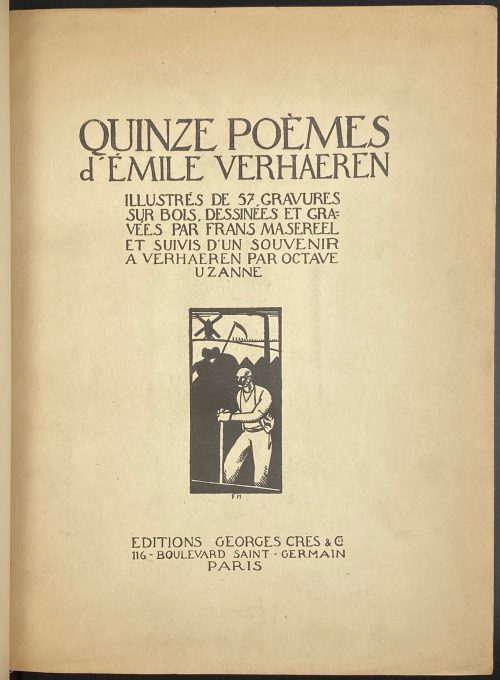 Quinze poèmes d'Emile Verhaeren. Illustrés de 57 gravures sur bois dessinées et gravées par Frans Masereel et suivis d'un 'Souvenir à Verhaeren' par Octave Uzanne. — Paris: Éditions Georges Crès, 1917. Authors: Emile Verhaeren (text), Frans Masereel (illustrations), Octave Uzanne (text). Publisher: Éditions Georges Crès. [Georges-Célestin Crès (1875 - 1935) was a French publisher and bookseller. Address: 116 boulevard Saint-Germain, Paris]. Printer: Sonor S.A. - Geneve, under the direction of Auguste Jordanis. The number of copies printed: 1555 of which 15 (1-15) on Japan paper, 190 (16-205) on Fabriano paper, and 1350 (206-1555) on English paper (1506-1555 not for trade). This copy № 1312. Pagination: [i] - front cover, [ii] - half-title, [iii] - title, [iv] - printrun justification, [v] - table of contents, [vi] - blank, [i-vii] viii-ciii, [civ] - printer statement, [cv] - back cover; one-side (recto) printing and pagination. Owner's contemporary red half-Morocco with marbled boards; spine with four raised bands, gilt lettering and design elements. Original printed paper wrappers preserved. Marbled endpapers. Trimmed unevenly.
Quinze poèmes d'Emile Verhaeren. Illustrés de 57 gravures sur bois dessinées et gravées par Frans Masereel et suivis d'un 'Souvenir à Verhaeren' par Octave Uzanne. — Paris: Éditions Georges Crès, 1917. Authors: Emile Verhaeren (text), Frans Masereel (illustrations), Octave Uzanne (text). Publisher: Éditions Georges Crès. [Georges-Célestin Crès (1875 - 1935) was a French publisher and bookseller. Address: 116 boulevard Saint-Germain, Paris]. Printer: Sonor S.A. - Geneve, under the direction of Auguste Jordanis. The number of copies printed: 1555 of which 15 (1-15) on Japan paper, 190 (16-205) on Fabriano paper, and 1350 (206-1555) on English paper (1506-1555 not for trade). This copy № 1312. Pagination: [i] - front cover, [ii] - half-title, [iii] - title, [iv] - printrun justification, [v] - table of contents, [vi] - blank, [i-vii] viii-ciii, [civ] - printer statement, [cv] - back cover; one-side (recto) printing and pagination. Owner's contemporary red half-Morocco with marbled boards; spine with four raised bands, gilt lettering and design elements. Original printed paper wrappers preserved. Marbled endpapers. Trimmed unevenly.


